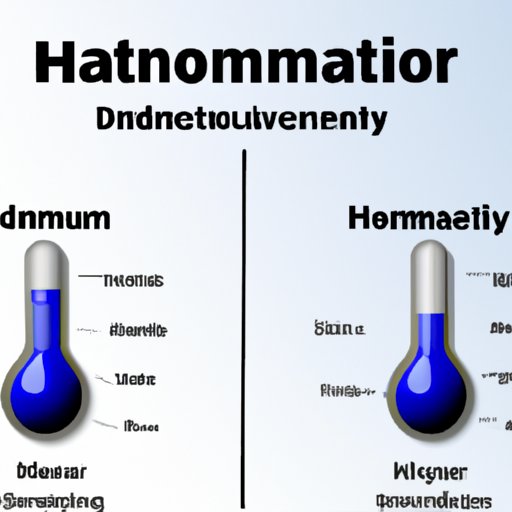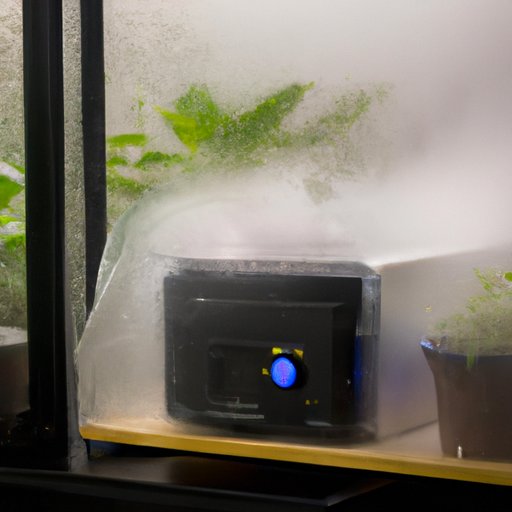Introduction
Humidity is a term used to describe the amount of water vapor present in the air. It is an important element that influences the weather, climate, temperature, health, and comfort of people around the world. In this article, we will explore how humidity works, the role it plays in weather and climate, the effects of high and low humidity on health and comfort, understanding relative and absolute humidity, and using humidity to control indoor environments.

The Role of Humidity in Weather and Climate
Humidity is one of the most important components of weather and climate. It affects everything from temperature to precipitation and can have both positive and negative effects. Let’s take a closer look at how humidity works and its role in weather and climate.
What is Relative Humidity?
Relative humidity is the measure of the amount of water vapor in the air compared to the maximum amount of water vapor the air can hold. It is expressed as a percentage and can range from 0% (no moisture) to 100% (saturated with moisture). The amount of water vapor the air can hold depends on the temperature of the air; warmer air can hold more water vapor than cooler air.
How Does Humidity Affect Temperature?
High humidity can make temperatures feel much hotter than they actually are. This is because the water vapor in the air acts as an insulator and traps heat close to the surface of the Earth. On the other hand, low humidity can make temperatures feel much colder than they actually are because there is less water vapor in the air to trap heat.
How Does Humidity Affect Precipitation?
Humidity also plays a major role in precipitation. When the air is saturated with moisture, the water vapor condenses into tiny droplets that form clouds. These droplets eventually become too heavy and fall as rain, snow, sleet, or hail. If the air is not saturated with moisture, then the water vapor does not condense and no precipitation occurs.
The Effects of High and Low Humidity on Health and Comfort
Humidity can have a significant impact on both physical and mental health. It can also affect comfort levels in different ways.
Health Risks Associated with High Humidity
High humidity can lead to an increased risk of respiratory illnesses such as asthma, allergies, and bronchitis. The moisture in the air makes it difficult to breathe and can irritate the lungs and throat. High humidity can also cause mold and mildew growth, which can trigger allergic reactions and worsen existing health conditions.
Health Benefits Associated with Low Humidity
On the other hand, low humidity can be beneficial for health. It helps to reduce the spread of airborne viruses and bacteria, making it easier to breathe and reducing the risk of infection. Low humidity can also help to reduce skin irritation and dryness.
Comfort Issues Associated with High or Low Humidity
High humidity can cause discomfort due to the sticky feeling it creates. It can also make it difficult to sleep as it can cause sweating and clamminess. Low humidity can cause dry skin, nosebleeds, and can make it difficult to stay warm in cold temperatures.

Understanding Relative and Absolute Humidity
In order to understand how humidity works, it is important to understand the difference between relative and absolute humidity. Let’s take a closer look at what absolute humidity is and how it is measured.
What is Absolute Humidity?
Absolute humidity is the measure of the actual amount of water vapor present in the air. It is usually expressed in grams of water vapor per cubic meter of air (g/m3).
Measuring Relative and Absolute Humidity
Relative and absolute humidity are measured using a hygrometer. A hygrometer is an instrument that measures the amount of water vapor in the air. It can measure both relative and absolute humidity and is often used to monitor humidity levels in homes and workplaces.
Calculating the Dew Point
The dew point is the temperature at which the air is saturated with water vapor and condensation begins to form. It can be calculated using the relative humidity and temperature readings taken by a hygrometer. Knowing the dew point can be useful when determining the likelihood of precipitation.

Using Humidity to Control Indoor Environments
Humidity can be controlled in indoor environments to create healthier, more comfortable living and working spaces. Here we will discuss the benefits of controlling humidity, methods for controlling humidity, and how to maintain a healthy indoor environment.
Benefits of Controlling Humidity
Controlling humidity in indoor environments can provide many benefits. It can reduce the risk of respiratory illnesses, prevent mold and mildew growth, reduce skin irritation and dryness, and improve overall comfort levels.
Methods for Controlling Humidity
There are several methods for controlling humidity in indoor environments. The most common method is using a dehumidifier, which removes excess moisture from the air. Other methods include using fans, air conditioners, and ventilation systems to circulate air and reduce humidity levels.
Maintaining a Healthy Indoor Environment
In order to maintain a healthy indoor environment, it is important to monitor and adjust humidity levels regularly. The ideal humidity level is between 40-60%, but this may vary depending on the season and the individual’s preferences. Regular monitoring and adjusting of indoor humidity levels can ensure a comfortable and healthy environment.
Conclusion
Humidity has a major impact on weather and climate, health, and comfort. Understanding how humidity works and how to control it can help to create healthier, more comfortable indoor environments. We hope this article has helped you gain a better understanding of humidity and the role it plays in our lives.
Summary of Key Points
• Humidity is the measure of water vapor in the air.
• High humidity can make temperatures feel hotter and can increase the risk of respiratory illnesses.
• Low humidity can make temperatures feel colder and can reduce the spread of airborne viruses and bacteria.
• Relative humidity is the measure of water vapor compared to the maximum amount of vapor the air can hold.
• Absolute humidity is the measure of the actual amount of water vapor in the air.
• Controlling humidity in indoor environments can reduce the risk of respiratory illnesses, prevent mold and mildew growth, reduce skin irritation and dryness, and improve overall comfort levels.
Advice for Managing and Controlling Humidity
• Monitor and adjust humidity levels regularly to maintain a healthy and comfortable indoor environment.
• Use a hygrometer to measure relative and absolute humidity levels.
• Use a dehumidifier to remove excess moisture from the air.
• Use fans, air conditioners, and ventilation systems to circulate air and reduce humidity levels.
(Note: Is this article not meeting your expectations? Do you have knowledge or insights to share? Unlock new opportunities and expand your reach by joining our authors team. Click Registration to join us and share your expertise with our readers.)
